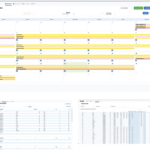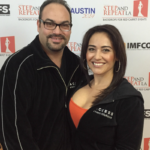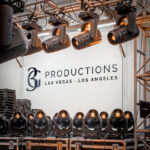Dakota Pride
The company was founded in 1968 by Drs. Aelred Kurtenbach and Duane Sander, professors of Electrical Engineering at South Dakota State University in Brookings, S.D. One of the original goals of the company was to offer an alternative to university graduates who were leaving the state for greater opportunities elsewhere.
While limiting the erosion of college graduates to bigger cities outside the state, the company also benefits from its proximity to the university, says Daktronics’ Matt Anderson, who his, himself, a graduate of Northern State University in Aberdeen, SD. “The advantages of having the university near is big — it offers a big engineering base,” says Anderson.
“The founders wanted to keep talented engineers in the state,” agrees Bo Ivers, who started at Daktronics in 2000. Originally in the sporting division, a few years ago he moved over to the Mobile/Modular Video Division focusing on the rental and staging industry.
Ivers acknowledges that South Dakota is not yet considered a major center of entertainment and technology, but he rattles off the pluses: low cost of living, friendly business environment, and that fabled Midwestern work ethic. “Midwesterners in general, and Dakotans in particular, have a work ethic so high that it helps create good products. We’re proud of our work, and proud to be part of making South Dakota the world leader in LED display technology.”
Earlier this year, Forbes magazine recognized Daktronics as one of the 100 most trustworthy companies. “Our customers know we’ll be here in the future,” Ivers says. “That we have integrity, that we are here to support them, are some of the most important things that we can offer.”
Today, the company’s primary manufacturing facilities are located in Brookings, S.D., Sioux Falls, S.D. and Redwood Falls, Minn. Daktronics employs 2,800 people worldwide.
Recent mergers and acquisition have helped get the company to that number: Star Circuits, a subsidiary acquired in 1987, designs and manufactures circuit boards used in Daktronics displays. In 2001, Daktronics acquired Keyframe Creative Services to better serve the sports and entertainment markets. In 2005, Daktronics acquired Dodge Electronics, a sound system designer and manufacturer. In 2006, the company acquired Hoffend & Sons Inc., makers of Vortek hoists and rigging systems.
An Unusual History
Those in the live event world will agree the company got into touring a most unusual way: First they made electronic voting systems, but in the early 1970s they had a breakthrough with their three-sided Matside Jr. Wrestling Scoreboard. That led to electronic billboards of all kinds, including that iconic Coca-Cola sign in New York’s Time Square. The company has also taken part in nearly every Olympics since 1978.
Daktronics’ foray in LED display technology began with fixed installations. From there, the company moved into the rental business, renting video displays for major sporting events. But they sold off that portion in 2007 so they would “no longer be competitors with people we want to have as customers,” Ivers says.
Throughout the LED revolution, the people at Daktronics found a need for more portable panels that can be building blocks for the demanding designers they sought to serve. “We realized we needed mobile, modular type of products that can go on stage and up in the air, and that’s how we made our entrance into live touring in a big way,” Ivers says.
Their first foray into live concert video could not have started bigger: In 1988, Michael Jackson went out on his Bad tour, and Daktronics was there, providing a 32-by-128-foot, 2.5-inch lamp matrix display. “It displayed Michael doing the moonwalk, and then the word ‘Bad’ spray painted across the display,” Anderson says. The tour grossed $125 million ($247 million in 2012 dollars), adding four new entries in the Guinness Book of World Records — the largest-grossing tour in history, the tour with the largest audience, the most successful concert series and the most sold-out shows at Wembley Stadium.
In recent years, Daktronics has continued to support tours with products engineered for visual impact and touring practicality. Another case in point in recent years is the Daktronics PST screens that debuted with a Brooks & Dunn tour in 2008.
Looks and Practicality
Today, the live event industry is asking for lighter products, not only for easier load-in and load-outs, but also to reduce the higher freight costs associated with heavier gear. Ivers says that, for a long time, Daktronics was always focused on the best-looking product, period, end of story. “But there’s been almost a philosophical change, as now that we’re there, we’re starting to focus more on the back end of the product.” Size, weight, and how easily pieces can fit together are key considerations with today’s new product development efforts.
Daktronics prides itself on working fast, too. Recently the company delivered 16 of their Vortek Classic hoists with an E Series control system in what must be near record time to Lanier High School in Austin, TX. The school called and ordered six custom (inverted) hoists for their renovation, to be delivered in five days. By the time Daktronics got to work, the school ordered another 10 hoists. They designed and manufactured a system that includes 16 Vortek Classic hoists with an E Series control system.
R&D Tweaking
Research and development is key to Daktronics, which cites a solid return on investment for those R&D efforts, not just for Daktronics, but for their customers as well. “We have one of the most rigorous testing labs that anyone has ever seen,” Ivers states. “Many customers who visit are envious of the people who report to the lab, saying they must have the best job in the world — trying to break products!”
The testing procedures include salt chambers to ensure reliable performance in harsh environments typical on cruise ships or seaside resorts, and Daktronics’ QC testers also inflict prototypes with extremes of heat and cold.
“We actually try to age our product rapidly to estimate how soon it might break to find a weak spot. We might expose it to more than a 100 degrees difference in 60 seconds.”
In addition to its torture tests, Ivers notes how Daktronics is always looking to improve the performance of products currently in its line — not to dazzle customers with a “must-have” fad, but to truly improve the production experience for all in the industry.
Two recent cases in point, according to Ivers: the tweaks Daktronics has made to its 10mm outdoor screen, now lighter (in weight), brighter and with an improved contrast ratio; and improvements in the company’s indoor screens targeted at high-end auto show clients.


